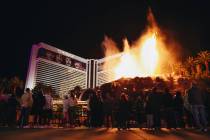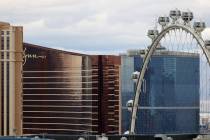These new hotel-casino names weren’t my idea
Memo to Las Vegas Review-Journal readers: Please stop calling, emailing and leaving me nasty messages about the planned Gansevoort Las Vegas.
I didn’t select the name.
Nor did I choose the names Quad, SLS, LVH, D, M and any other variation of the alphabet popping up around Las Vegas.
I know you dislike them.
Many of us long for the days when hotel-casino names on the Strip were Stardust, Sahara, Frontier, International, Barbary Coast, Aladdin, Dunes and Imperial Palace. OK, maybe not so much Imperial Palace.
It has been 2½ years since a new hotel-casino opened in Las Vegas. Resort development restarted this month after a hiatus because of the recession.
Announcements that Resorts World Las Vegas, SLS Las Vegas and Gansevoort Las Vegas will rise from the remnants of shuttered hotel-casinos may be just the start of the resurgence.
But all this activity is leaving us in a nostalgic mood.
It will be a long time before we see a new Stardust or Sahara, if ever.
In Las Vegas, it’s been out with the old and in with the new since Steve Wynn blew up the Dunes almost 20 years ago with a spectacular fireworks display. Bellagio now occupies the former Dunes site.
The reason behind getting rid of older brands hasn’t changed in two decades.
It’s about growing the customer base.
Which brings us to the Gansevoort (pronounced gan-se-voort).
The named sounds like a diagnosis you don’t want to hear from your doctor. (“I’m sorry Mr. Stutz, but there isn’t a cure for Gansevoort.”)
In reality, however, Gansevoort might part of the treatment for what ails Las Vegas.
With the Gansevoort name affixed to the former Bill’s Gamblin’ Hall, the building on the northeast corner of the Strip and Flamingo Road could lure the brand’s loyal customer base.
At least, that’s the hope of Caesars Entertainment Corp. officials. By jumping into a partnership with Gansevoort and nightlife maven Victor Drai, the casino operator believes the revamped property can tap into another Las Vegas visitor category.
Gansevoort customers are driven by the social scene. Guests pay more for personalized service, high-end accommodations, an upscale spa and fitness center, fine dining and a stylish nightlife.
In other words, the Gansevoort customer isn’t a Bill’s patron.
“It’s a new customer that will change the demographic of the location,” said Caesars Entertainment Chief Marketing Officer Tariq Shaukat.
In New York City, the Gansevoort Hotel Group operates two high-end, luxury boutique properties: the 186-room Gansevoort in the city’s Meatpacking District and the 249-room Gansevoort Park Avenue. The company also has a 91-room luxury Caribbean resort on Turks and Caicos.
Caesars will spend $185 million to transform Bill’s into a 188-room Gansevoort. Along with “Parisian apartment-style rooms,” a high-end restaurant overlooking the Strip, a new lobby area, and a 40,000-square-foot casino, the property’s signature element is a 65,000-square-foot roof-top pool deck with an indoor-outdoor nightclub managed by Drai.
“The hotel group has a loyal following, especially in their demographic,” Shaukat said.
That doesn’t mean the former Bill’s customers are being left out of the mix. Shaukat believes they will migrate next door to the Flamingo or across the street to Bally’s for the classic Las Vegas experience they found at Bill’s.
The Gansevoort, which is expected to open in 2014, mirrors other changes on the Strip.
The old Sahara crowd probably won’t be interested in SLS Las Vegas. SBE Entertainment is spending $400 million to redevelop the Rat Pack-era hotel-casino into a resort that will attract the company’s Sunset Strip-Hollywood Boulevard customer demographic to the desert. SBE is loading the SLS with some its popular restaurant and nightclub brands.
What SLS and Gansevoort can offer their customers in Las Vegas that isn’t found their other locations is obvious — gambling.
Former fans of the Stardust most likely will shy away from Resorts World Las Vegas. Malaysia-based Genting Group is planning target a largely middle-market international customer from Asia to the $2 billion to $7 billion development. The Asian customer is primarily a high-end gambler, so Resorts World could create a whole new customer classification for Las Vegas.
It has been almost seven years since the Stardust was imploded. The Sahara closed two years ago. The loyal customers have moved elsewhere. Some might have left Las Vegas.
California and Arizona have a combined 90 Indian casinos, the bulk of which are near the states’ population centers. Commercial casinos can now be found in Cleveland, Cincinnati, St. Louis, Philadelphia and other major U.S. cities. Casinos are slated for Boston and Baltimore while gaming leaders would love to drop legalized gambling into Miami and New York.
Competition is a major reason why Las Vegas needs to keep reinventing its offerings.
The recent Gaming Abstract from the Gaming Control Board showed nongaming activities accounted for 55.2 percent of the revenues hotel-casinos produced in fiscal 2012. On the Strip, the divide was more pronounced. Nongaming activities provided 64 percent of the total revenues from resorts.
Those statistics bring us back to casino name changes. An odd-sounding title might actually mean more business.
Sure, Gansevoort seems like a strange name for a Strip resort. Based on the planned casino’s new logo, Las Vegas followers may give the property their own nickname.
We’ll probably just call it the G.
Howard Stutz’s Inside Gaming column
appears Sundays. He can be reached at
hstutz@reviewjournal.com or 702-477-3871.
Follow @howardstutz on Twitter.












